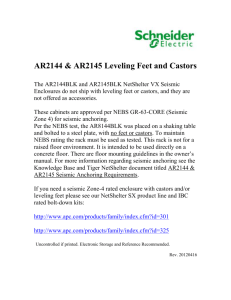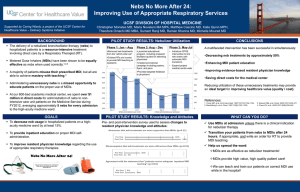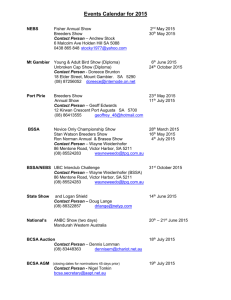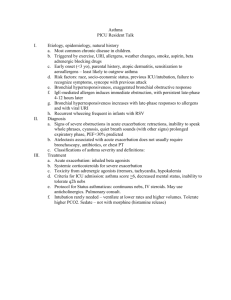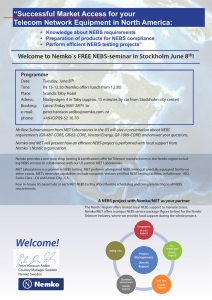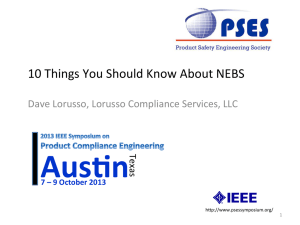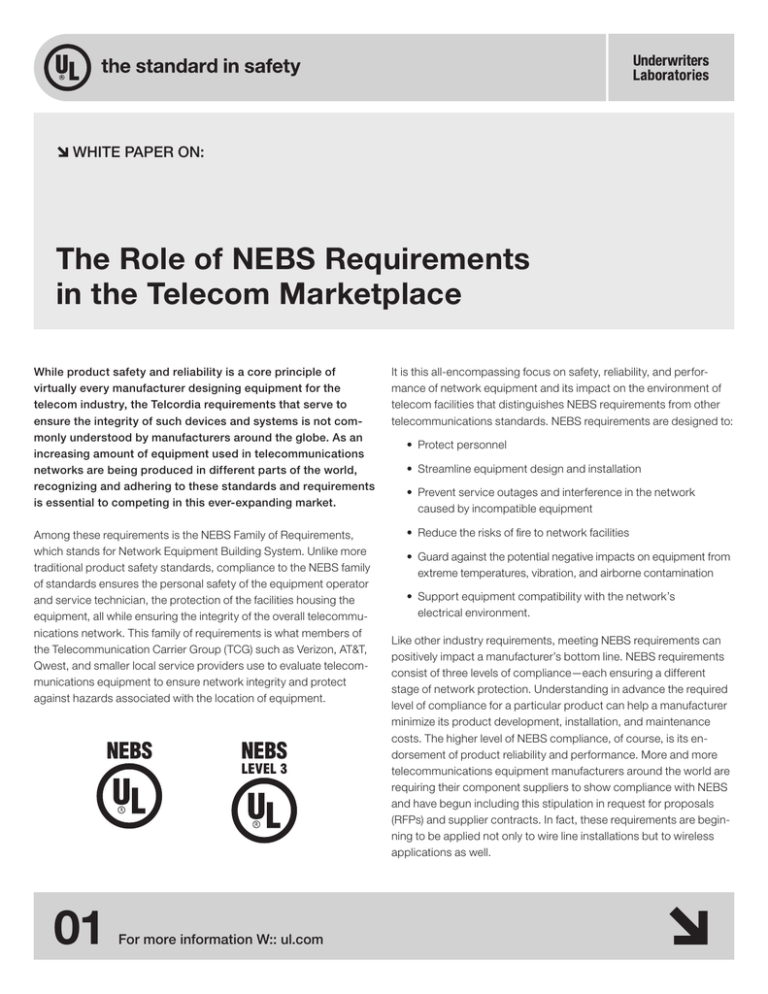
WHITE PAPER ON:
The Role of NEBS Requirements
in the Telecom Marketplace
While product safety and reliability is a core principle of
virtually every manufacturer designing equipment for the
telecom industry, the Telcordia requirements that serve to
ensure the integrity of such devices and systems is not commonly understood by manufacturers around the globe. As an
increasing amount of equipment used in telecommunications
networks are being produced in different parts of the world,
recognizing and adhering to these standards and requirements
is essential to competing in this ever-expanding market.
Among these requirements is the NEBS Family of Requirements,
which stands for Network Equipment Building System. Unlike more
traditional product safety standards, compliance to the NEBS family
of standards ensures the personal safety of the equipment operator
and service technician, the protection of the facilities housing the
equipment, all while ensuring the integrity of the overall telecommunications network. This family of requirements is what members of
the Telecommunication Carrier Group (TCG) such as Verizon, AT&T,
Qwest, and smaller local service providers use to evaluate telecommunications equipment to ensure network integrity and protect
against hazards associated with the location of equipment.
01
For more information W:: ul.com
It is this all-encompassing focus on safety, reliability, and performance of network equipment and its impact on the environment of
telecom facilities that distinguishes NEBS requirements from other
telecommunications standards. NEBS requirements are designed to:
• Protect personnel
• Streamline equipment design and installation
• Prevent service outages and interference in the network
caused by incompatible equipment
• Reduce the risks of fire to network facilities
• Guard against the potential negative impacts on equipment from
extreme temperatures, vibration, and airborne contamination
• Support equipment compatibility with the network’s
electrical environment.
Like other industry requirements, meeting NEBS requirements can
positively impact a manufacturer’s bottom line. NEBS requirements
consist of three levels of compliance—each ensuring a different
stage of network protection. Understanding in advance the required
level of compliance for a particular product can help a manufacturer
minimize its product development, installation, and maintenance
costs. The higher level of NEBS compliance, of course, is its endorsement of product reliability and performance. More and more
telecommunications equipment manufacturers around the world are
requiring their component suppliers to show compliance with NEBS
and have begun including this stipulation in request for proposals
(RFPs) and supplier contracts. In fact, these requirements are beginning to be applied not only to wire line installations but to wireless
applications as well.
Understanding levels of compliance
As most TCG members require demonstration of NEBS compliance
prior to the purchase and/or deployment on their telecommunication
network infrastructure, equipment manufacturers document compliance to NEBS requirements by having testing performed by an ISO
17025 approved third party test laboratory. In certain circumstances,
NEBS related testing can be performed in-house—assuming the internal laboratory is properly accredited (ISO 17025). However, some
TCG members require all testing to be performed by an accredited
independent test lab (ITL).
NEBS requirements apply to telecommunications equipment installed
in a Central Office (CO) environment, certain Outside Plant applications (OSP), and Customer Premises Equipment (CPE). There are
generally two standards that apply to most equipment designated for
use in a CO: GR-1089-CORE (Issue 4), which covers electromagnetic
compatibility and electrical safety; and GR-63-CORE (Issue 3), which
covers physical requirements. GR-1089-CORE and GR-63-CORE together are commonly referred to as the “NEBS Criteria.” It’s important
to understand that individual TCGs may have additional requirements
beyond those found in GR-1089-CORE and GR-63-CORE. Helping
to speed and simplify the compliance process without jeopardizing
network reliability in the deployment of new equipment, NEBS requirements are divided into three levels of compliance.
• Level 1 is the minimum acceptable level of NEBS environmental compatibility needed to preclude hazards and degradation of the network facility and hazards to personnel. Level 1
comprises only safety and risk criteria. Conformance to Level
1 does not assure equipment operability or service continuity.
Level 1 is typically used by the TCGs for early deployment into
their CO and/or interoperability lab, and to allow collocaters to
install equipment in a central office. A collocater is a company
that rents space in a central office and provides some type of
telephone service (such as Internet and long distance).
• Level 2 is the minimum level of NEBS environmental compatibility needed to provide some limited assurance of equipment
operability within the network facility environment. This assurance of operability is limited to the controlled or normal environments as defined by the criteria. Rarely a focus of customers,
Level 2 includes all requirements of Level 1 and adds some level
of operability reliability.
02
For more information W:: ul.com
• Level 3 is the minimum level of NEBS environmental compatibility needed to provide maximum assurance of equipment operability within the network facility environment. The Level 3 criteria
provide the highest assurance of product operability. Level 3
criteria are suited for equipment applications that demand minimal service interruptions over the equipment’s life. Most TCGs
require NEBS Level 3 prior to acceptance/installation on the
network as they require this level of compliance for equipment
operation in the central office, but not collocated equipment.
While SR-3580 is the Telcordia standard which dictates the tests
required by the three levels, most equipment manufacturers submit
their equipment to be evaluated to NEBS Level 3. Even in pursuing
the highest assurance of product operability that Level 3 provides,
manufacturers should know where their product is going to be
deployed on the network—in a CO operated by telecom carriers, an
outside plant environment, or a customer premises environment.
The setting of product deployment determines the tests that need
to be performed to meet NEBS requirements. For example, specific
environmental testing, in accordance with GR-63-CORE, simulates
exposure to extreme environments that include high/low temperatures, high humidity, shock and exposure, fire ignition and flame
spread, seismic conditions and airborne contaminates. By understanding the testing process, and the additional tests that may be
required by specific carriers, manufacturers are better able to work
most effectively and efficiently with third-party testing laboratories.
Recognizing the impact of industry trends
As a fully accredited, ISO 17025 independent test lab, UL is uniquely
qualified to assist in determining the application and installation environment, the appropriate level of compliance and, thus, the required
test plan for a given product. In fact, representatives of UL serve
on committees that help develop and revise industry standards.
Through the strength of its relationships with various TCGs, UL is
also expertly aware of the unique carrier requirements that complement the fundamental NEBS requirements in order to demonstrate
overall compliance. This knowledge and experience is vital in working with manufacturers in new and growing markets such as Asia intent on adapting to these traditionally North American requirements.
For example, in India the telecommunications and network infrastructure is in its infancy. Fueled in part by a local increase in demand
for both broadband and wireless subscriber services as well as the
globalization of telecommunications research and manufacturing,
this country is fast becoming an attractive destination for global
research and development (R&D) investments. Its growing and highly
educated population seems to be encouraging a government that
supports a robust R&D infrastructure with a regulated patent process
similar to many western countries.
This increasing worldwide investment in telecom infrastructure
coincides with the industry’s ongoing conversion from copper to
more efficient and cost-effective fiber-based systems. Carriers such
as AT&T and Verizon have made a great investment in fiber and
the equipment needed to deliver it. The growing need for products
able to convert from fiber to copper, and vice versa, opens up new
opportunities for equipment manufacturers focused on developing
products compatible with the North American market and beyond.
The promise of those opportunities hinges on a number of factors,
chief among them, manufacturers’ ability to comply with all
appropriate NEBS requirements.
Exploring qualified NEBS testing laboratories
Choosing the right NEBS service provider to work with involves
considering a host of issues, from laboratory capabilities and
accreditations to staff expertise. Equipment manufacturers might
also examine whether the provider is able to outline start dates and
availability for project planning well before testing actually begins.
In assessing provider capabilities, manufacturers should be aware
that product size and weight limitations might preclude some labs from
completing certain test profiles. In terms of certification, NEBS test
facilities should be ISO 17025 certified and qualified under any carrier
specific lab accreditation programs, such as the Verizon ITL program.
Manufacturers should inquire about the training and expertise of testing
staff. Lab staff and engineers should be actively engaged in industry
technical committees, regularly attend industry symposiums, and be
current with any applicable professional certifications.
It’s important to note that a comprehensive, full service laboratory
will support NEBS testing with the following test facilities:
• Full EMC test facility capable of conducting both immunity
and emissions testing
• Environmental chambers to conduct temperature and
altitude testing
• Vibration and seismic test facilities
• Full scale fire facility
• Facilities to support acoustic power measurements
03
For more information W:: ul.com
• Various test facilities to support lightning surge and power fault
simulations, DC power measurements
• Conditioning chambers to support mixed, flow and gas testing
and test apparatus to support hygroscopic dust exposure.
These labs should document and deliver a test report that outlines an
overall test strategy and contains individual test methods and results.
The report includes separate fire/seismic DVD’s and VHS tapes, which
is an RBOC requirement. Both CD and hard copy of test reports are
provided as part of the service provider’s base service.
Seeking out full service advantages
A full service laboratory should also be able to support the testing
process of the Verizon ITL program for manufacturers that seek
compliance with Verizon’s carrier specific requirements. Initiated to
help expedite product-to-market cycles for Verizon’s telecommunications equipment vendors and create more economical compliance
testing processes, the program actually incorporates three different
programs. These include:
1. ITL NEBS-TCP, or “Testing Certification Program,” which
is limited to third-party independent test labs; ITL NEBS-TCWP
2. “Testing Certification Witness Program,” which requires
100% witness testing by third-party ITL laboratory personnel
and allows select ITL labs to witness or conduct NEBS testing
at vendors’ or other laboratory facilities that are capable of
conducting NEBS testing
3. ITL FOC Program, or “Fiber Optic Component” program,
which allows select labs to witness or conduct NEBS testing at
vendors’ or other laboratory facilities that are capable of conducting
Fiber Optic Component testing and also requires 100% witness
testing by third-party ITL laboratory personnel.
The scope of accreditation under the Verizon ITL Program includes
standards GR-1089-CORE, GR-63-CORE, and GR-487-CORE.
As one of only a few Verizon approved ITLs, UL participates in all
three programs. For example, in its partnership with Verizon’s ITL
TCWP program, UL performs an initial assessment of the manufacturers’ test facility, including a review of all laboratory documents
and processes. It provides a written audit report with all findings
and assists in developing the necessary corrective actions to
ensure compliance with ISO 17025. UL also provides the manufacturer with technical support during the actual Verizon audit and
follows up with an annual audit of the manufacturer’s test facility to
ensure continued compliance with ISO 17025 and Verizon specific
requirements. Currently, there are no Asia-based manufacturer labs
involved with this program and, including UL, there are only three
ITLs authorized by Verizon to participate in the ITL TCWP.
A pioneer in NEBS testing since 1992, UL operates three full service
EMC facilities located throughout North America. Each has a variety
of NEBS capabilities and is staffed with highly trained, experienced,
and NARTE certified engineers. They have in-depth knowledge of
Telcordia and industry specifications and standards and extensive
telecommunications product knowledge. With a reputation for developing customized test plans and delivering highly repeatable and
accurate results using state-of-the art test equipment and measurement techniques, UL has developed and implemented a program
that allows telecom manufacturers to perform on-site NEBS related
testing under witness of a UL test engineer.
For more information, contact the following:
Frances Zhao
Sales Representative (Greater China)
UL-CCIC Company Limited
T:: +86 (512) 6808.6400 ext. 66724
E:: Frances.Zhao@cn.ul.com
Sobha Viju
Sales Representative, India
Underwriters Laboratories
T:: +91.80.4138.4418
E::Sobha.Viju@in.ul.com
No matter the current or future setting of laboratory testing, telecom
equipment manufacturers should ensure that their equipment undergoes proper NEBS and customer specific required testing. Viewing
this commitment as an important part of product investment, manufacturers should seek out an ITL with the technological tools and
expertise to carry out the testing process—including test methods
that address any modifications to requirements.
In understanding and achieving NEBS compliance, they gain
standing as a manufacturer whose equipment enhances rather
than jeopardizes network integrity and protects the safety of the
personnel who operate it. The return on this product investment
not only includes reduced design and related costs over the longterm, but the advantage of being positioned to make great strides
in an evolving worldwide marketplace that presents exciting, new
opportunities each and every day.
About the author:
Matt Marotto is currently North American EMC/NEBS Sales Manager
for Underwriters Laboratories. In 2008, Marotto served as Global NEBS
Program Development Engineer and was responsible for developing
and implementing UL’s NEBS Fastrack Program, which enables
international Telecom manufacturers to perform NEBS and telecom
related testing in their own laboratories under the witness of UL staff.
Prior to that, Marotto was Operations Manager for UL’s NEBS testing
laboratories in Research Triangle Park, North Carolina. Matt completed
his bachelor’s degree in electrical engineering from the University of
Alabama and is a NARTE Certified Product Safety Engineer.
04
For more information W:: ul.com
Copyright © 2010 Underwriters Laboratories Inc. All rights reserved 01/10 BDI 090912

